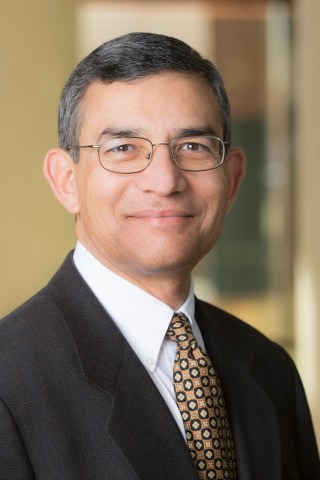
The U.S. economy abruptly plunged into a recession roughly a year ago, as the rapid spread of the coronavirus and ensuing shutdowns and stay-at-home orders dealt a devastating blow to many businesses and industries. This put in motion a dramatic spike in unemployment between March and April of 2020, which was unprecedented in the post-World War II era – peaking at 14.8% in April (seasonally adjusted).
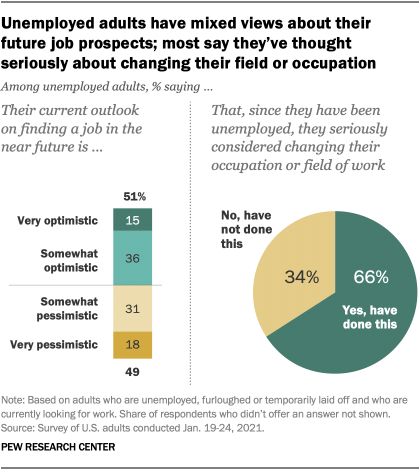
The unemployment rate has come down significantly since last spring, falling to 6.3% in January 2021. But labor market disruption remains a hallmark of the COVID-19 recession.
A new Pew Research Center survey finds that about half of U.S. adults who are currently unemployed, furloughed or temporarily laid off and are looking for a job are pessimistic about their prospects for future employment, and most say they’ve seriously considered changing fields or occupations since they’ve been unemployed. Many say they’ve experienced more emotional or mental health issues during the time they’ve been out of work.
The U.S. labor force has been hit hard by the COVID-19 recession. Pew Research Center conducted this study to understand how the recession has affected employment among major demographic groups as well as the experiences and outlook of people who are unemployed.
The survey analysis is based on 715 U.S. adults who are currently unemployed, furloughed or temporarily laid off and who are currently looking for work. The data was collected as a part of a larger survey of 10,334 adults conducted Jan. 19-24, 2021. Everyone who took part is a member of the Center’s American Trends Panel (ATP), an online survey panel that is recruited through national, random sampling of residential addresses. This way, nearly all U.S. adults have a chance of selection. The survey is weighted to be representative of the U.S. adult population by gender, race, ethnicity, partisan affiliation, education and other categories. Read more about the ATP’s methodology.
Here are the questions used for this report, along with responses, and its methodology.
The main data source for the analysis of labor force trends is the Current Population Survey (CPS). The CPS is the U.S. government’s official source for monthly estimates of unemployment. Read more here about the methodology used in this analysis.
The COVID-19 outbreak has affected data collection efforts by the U.S. government in its surveys, limiting in-person data collection and affecting the response rate. It is possible that some measures of labor market activity and how they vary across demographic groups are affected by these changes in data collection. For example, in April 2020, the unemployment rate may have been as high as 19.2%, instead of the 14.4% officially reported on a nonseasonally adjusted basis, if an adjustment is made for measurement errors, per BLS reports.
References to unemployed adults include those who are unemployed, furloughed or temporarily laid off and who are currently looking for work.
The unemployment rate is the number of jobless workers actively seeking work as a share of workers either at work or actively seeking work. Seasonally adjusted figures are used for the overall trend in unemployment; unemployment by demographic groups uses nonseasonally adjusted figures.
Job losses during the pandemic have hit workers in low-wage occupations particularly hard – something that distinguishes this downturn from the Great Recession, according to a new Pew Research Center analysis of government data. From December 2019 to December 2020, the percentage decrease in employment in low-wage occupations was more than twice as great as in middle-wage occupations (-12.5% vs. -5.3%). At the same time, employment in high-wage occupations increased marginally over this period.
The Center’s survey, conducted Jan. 19-24, finds that 49% of adults who are unemployed and looking for work say they are pessimistic they will find a job in the near future: 18% are very pessimistic about this and 31% are somewhat pessimistic. A similar share (51%) are optimistic, with 15% saying they are very optimistic and 36% saying they are somewhat optimistic.
For some, that positive outlook comes with a caveat. Among those who say they’re optimistic about finding a job, a substantial minority – 37% – say they are not too or not at all confident they will find a job that pays as much and provides the same benefits they had in their last job. Among all unemployed adults, 55% say they are not confident they’ll find a job with the same income and benefits; 45% say they are somewhat or very confident this will happen.
Not only are many unemployed adults feeling discouraged about their future job prospects, two-thirds say that, since losing their jobs, they have seriously considered changing their occupation or field of work. This sentiment is shared by lower-income unemployed adults, as well as those with middle or upper incomes. (Incomes are based on 2019 earnings.) A third of unemployed adults say they have already taken steps to retool their skills by pursuing job retraining programs or educational opportunities.
Even so, most unemployed adults (70%) believe they have the education and training they need to get a job. Those with a bachelor’s degree or more education (87%) are more likely to say this than those with less education (66%).
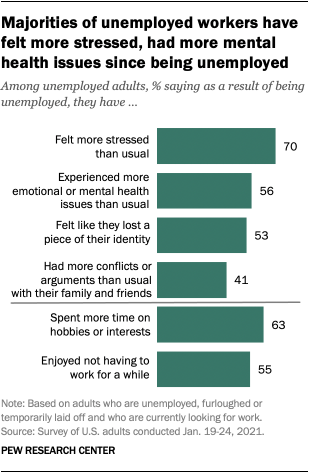
The psychological toll of job loss is apparent in the survey findings. Seven-in-ten unemployed adults say, as a result of being unemployed, they have felt more stressed than usual, and 56% say they have experienced more emotional or mental health issues, such as anxiety or depression. Some 53% say they have felt like they lost a piece of their identity, while 41% say they’ve had more conflicts or arguments than usual with family and friends. Overall, roughly eight-in-ten unemployed adults (81%) say they have experienced at least one of these negative consequences since they have been unemployed.
Unemployed adults with a bachelor’s degree or more education (65%) are more likely than those without a four-year college degree (54%) to say they have experienced more emotional or mental health issues than usual as a result of being unemployed. Middle- and upper-income unemployed adults (65%) are more likely than those with lower incomes (46%) to say they’ve felt like they lost a piece of their identity.
On the positive side, many see advantages to the change in their employment situation. A majority of unemployed adults (63%) say they have spent more time on hobbies or interests since being unemployed and 55% say they have enjoyed not having to work for a while.
Rise in unemployment has been more pronounced for Hispanic workers, younger workers and those without a bachelor’s degree
In December 2020, the U.S. unemployment rate stood at 6.5% (nonseasonally adjusted), roughly 3 percentage points higher than the rate in December 2019 (3.4%), before the coronavirus outbreak. Initially, the increase in unemployment fell disproportionately on certain demographic groups, such as Hispanic women, immigrants, young adults and those with lower levels of education. Going into the economic downturn, more workers in these groups than their share of the workforce overall had jobs in industries that were most vulnerable to the economic shock that was coming.
Almost one year later, similar demographic patterns of job loss persist. Hispanic workers (both women and men), younger workers and those with less education have seen larger percentage point increases in unemployment compared with other workers.
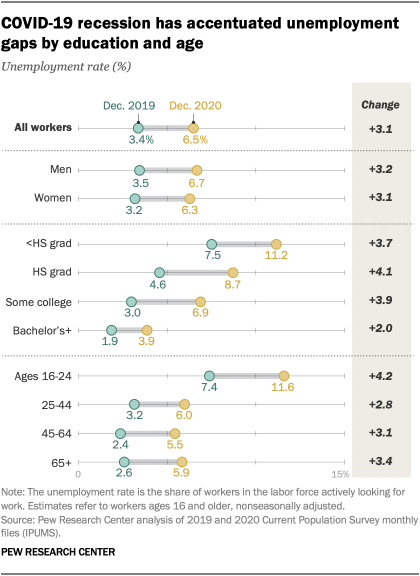
While men and women overall have experienced roughly equal increases in the unemployment rate, there are some gender differences within racial and ethnic groups. Among Black and Hispanic workers, men experienced a greater increase in unemployment from December 2019 to December 2020 than women. Among Asian workers, women fared worse than men.
There are also notable differences by age and education. The unemployment rate among the youngest workers (ages 16 to 24) rose by 4.2 percentage points from December 2019 to December 2020. For other age groups, the increase was closer to 3 points.
A bachelor’s degree provided some level of protection for workers during the COVID-19 recession. Unemployment increased by only 2 points for this group, while it went up by about 4 points for those with less education.
From 2019 to 2020, employment fell more sharply in low-wage jobs
Looking at the patterns of job loss by occupation underscores the disproportionate impact the pandemic has had on the financial lives of lower-income Americans. In 2020, the percentage loss in employment was greatest among low-wage occupations. The gaps were most dramatic in the early months of the recession. Employment in low-wage occupations was down 33.9% in April 2020 from April 2019. The loss was 14.1% in middle-wage occupations. Employment in high-wage occupations was 2.6% higher in April 2020 than in April 2019.
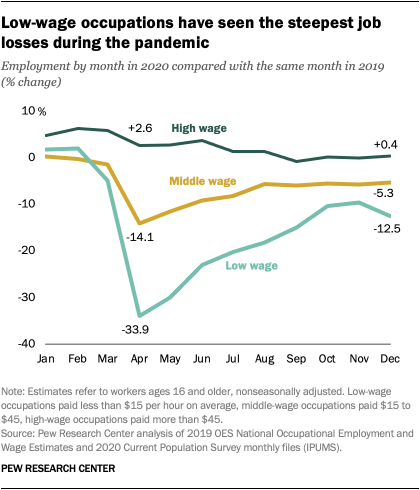
From December 2019 to December 2020, employment in low-wage occupations decreased by 12.5%, compared with a loss of 5.3% in middle-wage occupations and an increase of 0.4% in high-wage jobs.
This pattern is in stark contrast to what happened during the Great Recession. From December 2007 to December 2009, job losses were most severe among middle-wage occupations. Employment in low- and high-wage occupations was only modestly affected during that period.
The key difference between the two recessions is that the Great Recession hit the construction and manufacturing sectors the hardest. These sectors paid much higher wages than leisure and hospitality, the industry hit hardest in the COVID-19 recession. Within low-wage occupations, job losses during the current recession have been highest among waiters and waitresses, cashiers, chefs and cooks, retail salespersons and maids and housekeeping cleaners. In a striking contrast, among low-wage occupations, seven of the 10 job categories that have let go of the most workers in the COVID-19 recession hired the most workers during the Great Recession.
Among middle-wage occupations, those leading in job losses in the COVID-19 recession have been a mixed bag: taxi drivers and chauffeurs, secretaries and administrative assistants, accountants and auditors, driver/sales workers and truck drivers, and laborers and material movers. Teachers have also lost large numbers of jobs.
Jesse Bennett, research assistant, contributed to this analysis.
Note: Here are the questions used for this report, along with responses, and its methodology.


